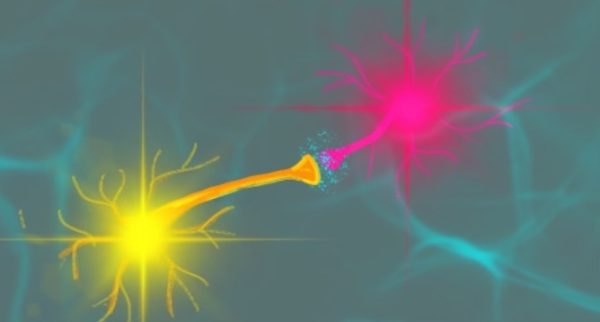A Georgetown University pharmacology and physiology professor gave an overview of “The World of GABA” in the annual Stephen and Mary Krop Lectureship in Pharmacology April 12.
Dr. Paul Krop (CAS ’65, MED ’69) and Dr. Tom Krop started the lecture series in 2000 to commemorate the legacy of their father, Stephen Krop (GRD ’40), a pharmacologist whose work pioneered treatments for chemical warfare agents and ways to detect drugs in the body, among many other accomplishments. This year’s lecture, in the Schering Foundation Library, featured Stefano Vicini, professor in the department of pharmacology and physiology, who surveyed the expansive field of research on a crucial molecule in the brain.
Tom Krop said the lecture series works to advance innovative perspectives, something he said his father always sought to facilitate through important scientific conversation and collaboration.
“Dad believed in spreading research results, new ideas and approaches to therapy between doctors and institutions, and I feel that this lecture series accomplishes that goal,” Tom Krop wrote to The Hoya.
Gamma-aminobutyric acid (GABA), the most common inhibitory neurotransmitter in the brain and spinal cord, played the role of protagonist in Vicini’s talk. GABA slows electrical impulses between nerve cells, or neurons, which is important for sleep, muscle relaxation and anxiety control. Due to its myriad effects, GABA is widely used in therapeutic drugs to treat neurological and psychological disorders, from nerve-related pain to anxiety.
Over the years, Vicini and many other researchers have studied how GABA affects larger brain processes, including its role in therapeutics.
“My study linked the function of GABA channels (opening and closing) to the duration of the synaptic activation that underlies the frequency of the brain waves,” Vicini wrote to The Hoya.
Vicini also explained the mechanism by which these brain waves are propagated. Electrical impulses are controlled by the entry of charged molecules into neurons. If positive charge flows in, the impulse is allowed to travel. GABA, however, slows these impulses by binding to a receptor, causing the flow of negative charge into the cells instead.
Synthesized in 1883 — about 70 years before it was discovered in the brain — GABA’s complexity eluded researchers for decades before the intricacies of its effects came to light by researchers like Vicini.

Vicini also noted that GABA has important links to Parkinson’s disease. Vicini’s team found that one of GABA’s cellular functions could have important clinical applications in such efforts.
This function, Vicini explained, is called tonic inhibition. This is when free GABA molecules that exist in the fluid surrounding neurons bind to a unique type of GABA receptor that is not confined to the synapse, where neurotransmitters are usually released.
“Because tonic inhibition provides a powerful mechanism to regulate excitability of key neurons in the basal ganglia, it may serve as a novel therapeutic target for the ameliorating motor disturbances associated with Parkinson’s disease,” Vicini wrote.
To study the effect of benzodiazepines — a class of depressants that also bind to the GABA receptor — Vicini said one has to look at the synapse, or the gap between the neuron that is releasing GABA and the cell that is receiving it.
“If you want to study what happens at the synapse, you have to become a synaptic vesicle,” Vicini said during the event.
A synaptic vesicle is a bubble-like structure that houses neurotransmitters before they are released from the end of a neuron. To envision what is happening at the cellular level, Vicini said he and other researchers use the patch-clamp technique, where a small “patch” of cell membrane containing GABA receptors is isolated, and the voltage, or movement of ions, across individual channels is measured.
“The patch-clamp technique allowed my lab and those of others to observe the effects of the benzodiazepines on the GABA channel and, consequently, the prolonged duration of the synaptic inhibition,” Vicini wrote.
These experiments also revealed that benzodiazepines uniquely affect different types of GABA receptors, influencing sleep, anxiety and memory formation.
John Partridge, associate professor in the department of pharmacology and physiology and longtime colleague of Vicini, noted that, ultimately, the clinical applications of these substances rely on the gating of ion channels.
“All of these drugs that are very clinically useful, benzodiazepines, general anesthetics, even alcohol, all contribute to the opening and closing of these channels that allow the flux of electricity through excitable cells, like the ones that are in our brain,” Partridge told The Hoya.
Although Vicini gave an overview of many researchers’ discoveries, Vicini’s own contributions to the field of GABA research for the past 40 years are extensive, as echoed by Partridge.
“His influence has really put an extremely positive light on Georgetown and the importance of research, and associating Georgetown with research heading into the future,” Partridge said.








